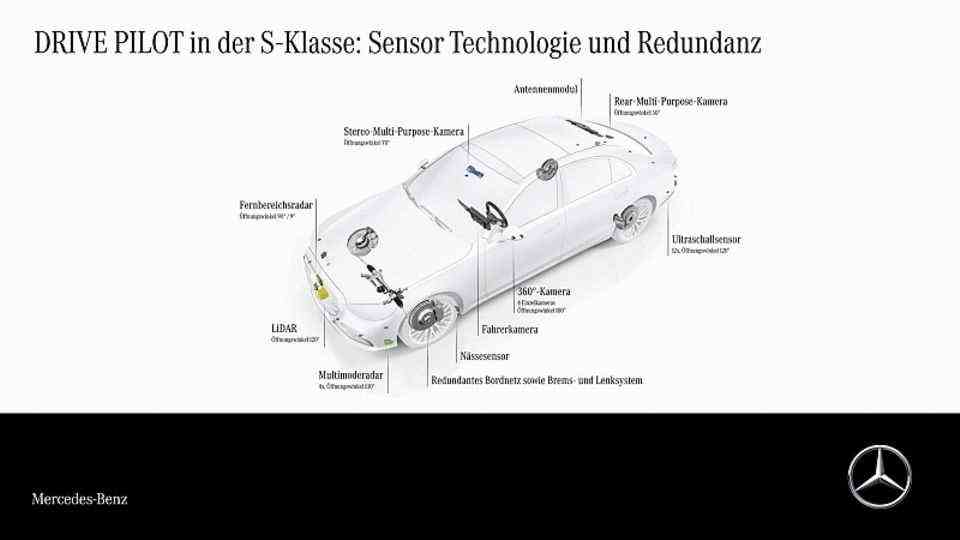KBA approval for Mercedes DrivePilot
Moon landing
Mercedes Drive Pilot
© press-inform – the press office
Mercedes has received level 3 approval for autonomous driving from the Federal Motor Transport Authority. So the Swabians show not only BMW and Audi, but also Tesla the taillights. But that is only the beginning.
Markus Schäfer is not someone who tends to have great emotional outbursts. But when the Mercedes technical director speaks the sentence “we succeeded in landing on the moon”, he proudly shows it clearly. The joy is understandable, because Schäfer announces in the same breath that Mercedes use the “Drive Pilot” on the German autobahn and thus level 3 automated driving is possible up to 60 km / h. This makes Mercedes the first automobile manufacturer to be allowed to incorporate this function in its vehicles. Audi had already introduced a similar system a few years ago in the A8, but failed when it was approved. Originally, BMW also wanted to open the door to an independently operating car this year. The implementation of the ambitious plans is still a long way off.
Unlike with Mercedes. “On December 2, 2021, the Federal Motor Transport Authority (Kraftfahrt-Bundesamt) issued the world’s first type approval in the field of automated driving for an Automated Lane Keeping System (ALKS) for a model from the manufacturer Mercedes-Benz. The basis is UN regulation No. 157, which defines internationally harmonized safety requirements for automated lane-keeping systems, “says a KBA press release bulky. This is an important step towards autonomous driving, because the transition from level 2 plus, which many cars are currently capable of, to level three is gigantic. Ultimately, the driver hands over responsibility to the technology, which has a whole bunch of consequences. Above all, the liability. If the vehicle is driving autonomously and has an accident, the manufacturer is not liable to the driver.
We’ll start with the S-Class, which will be available with the Robo-Chauffeur from the middle of next year. Two or three months later, the electric flagship EQS is on its way. Markus Schäfer cannot yet say how high the surcharge will be. The board of directors for technical development expects the demand to be quite high. “That showed the interest in the hyperscreen, which exceeded our expectations,” explains the manager. However, the owners of the current S-Class are looking into the tube. Due to the high technical complexity, the system cannot be retrofitted. “We are always open to a second S-Class in our fleet,” says Markus Schäfer with a wink. The surcharge for the system should not be astronomical. The rollout to other segments is still in the stars, but is technically possible.
The road to this auto pilot was rocky. In order for the system to work, a new LIDAR unit and new high-performance cameras had to be developed together with the suppliers. The Mercedes engineers wrote the software themselves. Safety is a top priority at Mercedes. Independently zigzag driving S-Classes would be anything but beneficial for the image of the German premium car maker. “That’s why some things take a little longer,” says Markus Schäfer. In addition, there are several test kilometers to get the system stable. Unlike Tesla boss Elon Musk, who, according to the New York Times, is of the firm opinion that camera-based systems are sufficient to make the autopilot suitable for everyday use, the Mercedes engineers rely on a whole bunch of sensors, cameras and radar units. “Redundancy is important,” explains Markus Schäfer. At least two systems must always be functional and monitor the traffic. If this is not the case, the driver has to take command again. Incidentally, even when he falls asleep or reads the newspaper because his eyes are not visible.
To ensure liability, every driving maneuver is recorded and the system must be constantly up to date. Therefore, in addition to UN regulation No. 157, UN-R 155 (cybersecurity) and UN-R 156 (software updates) have also been incorporated into the development. This is to ensure that the vehicle is always up to date and that the data is secure. The latter is important. After the German market, the system is to be launched in the USA and China. But in the Middle Kingdom, the regulations can differ from province to province or in the big cities, which delays approval. Shenzen has now made the start and tied down the parameters for autonomous driving.
Technically, it is not a problem to bring the robotic chauffeur to other markets. It is only important that the legal framework is right. “The question is also how big the markets are,” says Markus Schäfer. At Mercedes, they are already working on the next expansion stages of the Drive Pilot. The plan includes speeds of up to 130 km / h and automated lane changes. “Luxury is also the time the driver has”; explains Markus Schäfer. The variety of functions also has other effects. In the case of the S-Class, the system now has access to around 50 control units, so subscription transactions can also be carried out to activate new elements.
At Mercedes, meanwhile, they are looking ahead. The engineers are currently working on the next generation of the infotainment system. The Swabian car manufacturer wants to keep the fate in its own hands. That is why Mercedes defines the hardware including the computer chips. It is already clear that the software will also come from Sindelfingen and the surrounding area. The next steps in autonomous driving should then also go hand in hand with the new command center.


